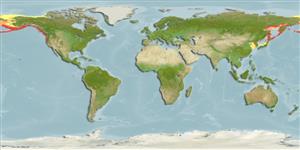An anadromous species which inhabits ocean and coastal streams (Ref. 5723, 86798). Epipelagic (Ref. 58426). Pelagic at the sea. In freshwater, lives in Montane and Piedmont rivers with moderate to fast current and gravel bottom. Spawns in riffles or at head of riffles in shallow water with current up to 1.5 m/s, and clean coarse gravel (Ref. 59043). Spends 18 months at sea after which spawning migration to the natal river or stream occurs; but because the species is less certain of its homing and there is a certain degree of wandering, streams as much as 640 km from natal streams may be used (Ref. 1998, 27547). Upon emerging from the gravel, fry immediately move downstream and remain inshore for a few months before going out to sea. Fry may feed on nymphal and larval insects while in fresh water, but may not feed at all. In the sea, young feed on copepods and larvacean tunicates, its diet shifting to amphipods, euphausiids and fishes as the fish grows (Ref. 27547). Other food include ostracods, decapod larvae, cirripeds, tunicates, dipterous insects (Ref. 1998, 27547). Fry may be preyed upon by birds and mammals while adults by marine mammals and large fish (Ref. 1998). Mostly sold canned (Ref. 1998) but also utilized fresh, smoked, and frozen; also valued for caviar, especially in Japan; eaten steamed, fried, broiled, boiled, microwaved, and baked (Ref. 9988). The smallest of the true salmon (Ref. 12218).
度过在海上的 18个月此后产卵回游到出生的河,否则水流出现; 但是因为此鱼种它的归巢是比较不某些而且有一个流浪的特定程度, 来自出生的溪流的溪流高达 640 公里可能是使用过的.(参考文献 1998,27547) 一从砾石出现,鱼苗紧邻在去向外到海洋之前移动下游而且保持近海数个月。 (参考文献 27547) 鱼苗可能吃 nymph 的与昆虫幼虫在淡水中的时候, 但是可能根本不吃。 在海洋中, 幼鱼捕食桡脚类的动物与 larvacean 被囊类, 它的食性转移到片脚类动物, 磷虾与鱼当鱼生长.(参考文献 27547) 其他的食物包括介形虫,十足目幼生,蔓脚类动物,被囊类,双翅目昆虫昆虫。 (参考文献 1998,27547) 鱼苗可能是被鸟与哺乳动物捕食虽然成鱼被海洋哺乳动物与大的鱼.(参考文献 1998) 大部份装成罐头销售 (参考文献 1998)了也被烟熏的生鲜利用 , 与冷冻; 也为鱼子酱评价了, 尤其在日本; 清蒸,油炸,火烤, 煮沸, 微波了, 而且烧烤了.(参考文献 9988) 最小的真实鲑鱼.(参考文献 12218) 这种的阿拉斯加州鲑鱼渔场已经被检定藉由海洋的总管职务会议 (http:// www.msc.org/) 当管理良好且族群能维持。
Preferred temperature (Ref.
115969): 0.5 - 9.3, mean 3.3 (based on 572 cells).
Phylogenetic diversity index (Ref.
82804): PD
50 = 0.5000 [Uniqueness, from 0.5 = low to 2.0 = high].
Bayesian length-weight: a=0.01148 (0.00644 - 0.02046), b=3.08 (2.92 - 3.24), in cm Total Length, based on LWR estimates for this species & Genus-body shape (Ref.
93245).
营养阶层 (Ref.
69278): 4.5 ±0.4 se; based on diet studies.
回复力 (Ref.
120179): 中等的, 族群倍增时间最少 1.4 - 4.4年 (tm=2; tmax=3; Fec=800).
Prior r = 0.55, 95% CL = 0.37 - 0.83, Based on 4 full stock assessments.
Fishing Vulnerability (Ref.
59153): Moderate to high vulnerability (50 of 100).
Climate Vulnerability (Ref.
125649): Moderate to high vulnerability (46 of 100).
